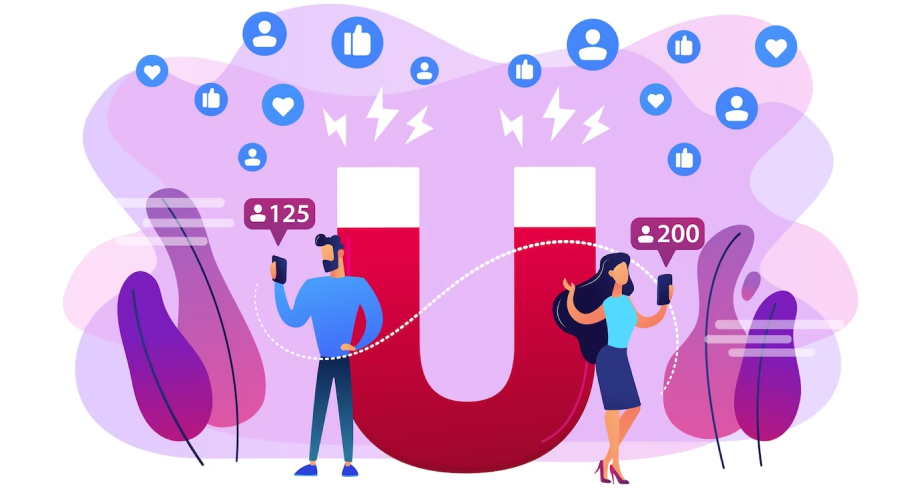1.Understanding Your Target Audience
One of the most crucial steps in effective lead generation is understanding your target audience. To generate high-quality leads, you need to know who your ideal customer is and what their pain points, needs, and preferences are. Start by creating a detailed customer profile that includes demographics, psychographics, and behavior. You can gather this information by conducting surveys, analyzing your website analytics, or using customer relationship management (CRM) software. Once you have a clear understanding of your target audience, you can tailor your marketing efforts to meet their preferences and needs.
2.Building a Strong Brand Identity
Building a strong brand identity is essential for effective lead generation. Your brand identity is the visual and emotional representation of your brand, and it helps your business stand out in a crowded market. Your brand Identity should be consistent across all your marketing channels, including your website, social media profiles, and email campaigns. Some elements of a strong brand identity include a compelling brand story, a unique logo, consistent colors and fonts, and a consistent tone of voice.
3.Creating Valuable Content
Creating valuable content is one of the most effective ways to generate leads where your content should be informative, educational, and engaging, and it should address your target audience's pain points and needs. Some types of content that are effective for lead generation include blog posts, whitepapers, ebooks, infographics, and videos. Make sure to optimize your content for search engines by using relevant keywords, meta descriptions, and title tags.
4.Optimizing Your Website for Lead Generation
Your website is often the first point of contact between your brand and potential customers. So, it is essential to optimize your website to maximize lead generation. Some key elements of a lead-generating website include a clear value proposition, easy navigation, strong calls to action, and mobile responsiveness. You should also ensure that your website is optimized for search engines by using relevant keywords, meta descriptions, and title tags.
5.Leveraging Social Media for Lead Generation

Social media platforms such as Facebook, Twitter, and LinkedIn can be effective channels for lead generation. To leverage the power of social media, you should create engaging and shareable content that resonates with your target audience. You should also use social media advertising to reach a wider audience and target prospects based on demographics, behavior, or interests. Social media contests, quizzes, and surveys are also effective strategies for generating leads.
6.Implementing Email Marketing Campaigns
Email marketing is a powerful tool for lead generation, as it allows you to communicate with potential customers on a regular basis. To implement email marketing for lead generation, you should create a series of automated email campaigns that deliver valuable content, offers, and information to your prospects. You should also segment your email list based on factors such as demographics, behavior, or interests, to ensure that your messages are relevant and targeted.
7.Investing in Paid Advertising
Paid advertising can be an effective way to generate leads quickly. Some types of paid advertising that are effective for lead generation include search engine marketing (SEM), display advertising, social media advertising, and retargeting. To get the most out of your paid advertising campaigns, make sure to target your ads to your ideal customer profile, use compelling ad copy and imagery and track your results to optimize your campaigns over time.
8.Hosting Webinars and Events

Hosting webinars and events is an excellent way to generate leads and establish thought leadership in your industry. Webinars and events offer a platform to share valuable insights, knowledge, and expertise with your target audience. When hosting a webinar or event, you should create a landing page that promotes the event and encourages visitors to register. You can also use social media, email marketing, and paid advertising to promote your webinar or event.
During the webinar or event, you should focus on providing valuable information and insights to your audience. You can also use this opportunity to interact with your audience and answer their questions. At the end of the webinar or event, you should offer a call to action that encourages attendees to learn more about your products or services.
Some tips for hosting a successful webinar or event include:
- Choose a topic that is relevant to your target audience
- Use a catchy and informative title for your webinar or event
- Promote your webinar or event through various channels
- Use a professional and engaging presentation format
- Encourage interaction and engagement from your audience
- Provide valuable and actionable takeaways for your attendees
- Follow up with attendees after the webinar or event to nurture the leads
9.Offering Free Trials and Demos
Offering free trials or demos is an effective way to generate leads and demonstrate the value of your product or service. Free trials and demos provide potential customers with the opportunity to test your product or service before committing to a purchase. This can help build trust and establish your brand as a credible and reliable solution provider.
When offering free trials or demos, you should create a landing page that highlights the benefits of your product or service and encourages visitors to sign up. You can also use email marketing and social media to promote your free trial or demo. Once the potential customer signs up, you should provide them with clear instructions on how to use the product or service and offer them support if needed.
Some tips for offering free trials or demos include:
- Clearly communicate the value proposition of your product.
- Provide easy-to-use instructions for the trial or demo.
- Offer excellent customer support during the trial or demo period.
- Follow up with potential customers after the trial or demo to nurture leads.
- Consider offering a limited-time discount for customers who sign up after the trial or demo period.
10.Measuring and Analyzing Your Lead Generation Efforts

Measuring and analyzing your lead generation efforts is essential to improving your marketing strategy and achieving better results. By tracking key metrics such as website traffic, conversion rates, and lead quality, you can identify areas of improvement and adjust your strategy accordingly.
To measure and analyze your lead generation efforts, you should use tools such as Google Analytics, CRM software, and marketing automation platforms. These tools can provide valuable insights into your website traffic, lead generation sources, and lead nurturing campaigns.
Some metrics to track include:
- Website traffic and engagement
- Conversion rates
- Lead quality and quantity
- Cost per lead and customer acquisition cost
- ROI of your marketing campaigns
By regularly measuring and analyzing these metrics, you can identify areas of improvement and adjust your strategy to achieve better results.
Conclusion
Lead generation is a critical component of any successful marketing strategy. By understanding your target audience, optimizing your website and landing pages, creating valuable content and offers, and leveraging various marketing channels, you can generate high-quality leads and drive business growth. Remember to measure and analyze your lead generation efforts regularly to identify areas of improvement and achieve better results over time. With the right strategies and tactics in place, you can master lead generation and take your business to the next level.





